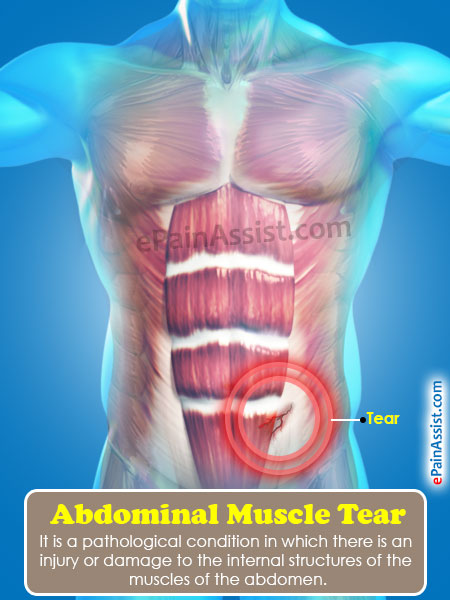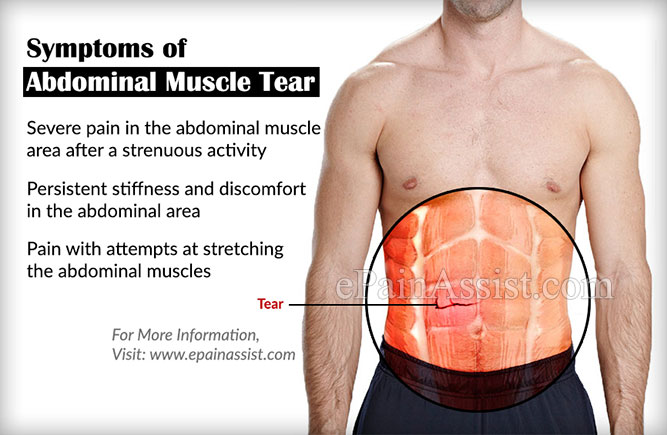What is Abdominal Muscle Tear?
An Abdominal Muscle Tear Which is also known as Abdominal Muscle Strain is a pathological condition in which there is an injury or damage to the internal structures of the muscles of the abdomen. A strain can be described as a partial or complete tear of a muscle. In majority of the cases, the strains or tears are very minute and may lead to some kind of discomfort in the affected area but in some cases there is a complete tear where the muscles pull away from each other then it that case it is called as a muscle rupture, in this case the Abdominal Muscle Rupture. The abdominal muscles are situated around the abdomen and the trunk and form the core muscles of the body.

What Causes Abdominal Muscle Tear?
The root cause for an Abdominal Muscle Tear or Strain is overuse of the abdominal muscles. This can be due to many strenuous activities which an individual does on a daily basis either at work or at home. Abruptly starting to lift excessive amount of weight without making the body ready for it may cause Abdominal Muscle Tear. Individuals who are involved in wrestling also tend to injure their abdominal muscles. Also, Abdominal Muscle Tear can be caused due to not using appropriate technique for lifting weights or exercising. Repetitively lifting heavy weights at work also may cause Abdominal Muscle Tear. Due to some reason if you are made to twist the body suddenly then it may cause an Abdominal Muscle Tear.
What are the Risk Factors for Abdominal Muscle Tear?
Some of the risk factors for an Abdominal Muscle Tear are:
- Not giving enough time to stretching before starting an exercise routine
- People who overexert their abdominal muscles are at risk for an Abdominal Muscle Tear
- Wrong techniques while using the Abdominal Muscles while playing sports puts the abdominal muscle at risk for a tear
- People with a weak back muscles are at risk for Abdominal Muscle Tear
- Individuals exercising in extremely cold weather tend to put their abdominal muscles at risk for a tear or a strain.

What are the Symptoms of Abdominal Muscle Tear?
Some of the caused due to an Abdominal Muscle Tear are:
- Severe pain in the abdominal muscle area after a strenuous activity
- Persistent stiffness and discomfort in the abdominal area
- Pain with attempts at stretching the abdominal muscles
- Tenderness in the abdominal area along with muscle spasms
- In severe cases of Abdominal Muscle Tear there may be swelling of the abdominal muscles.
How is Abdominal Muscle Tear Diagnosed?
The physician may diagnose Abdominal Muscle Tear or Strain by taking a detailed history and the symptoms that the patient experiences. The physician will also ask as to whether the patient has been doing any activities that may tear or strain the abdominal muscles. The physician will then conduct a physical examination to look for tenderness over the abdominal muscles and pain when contracting the abdominal muscles. The physician may also order other radiologic studies to rule out other causes for the symptoms. Once an Abdominal Muscle Tear or Strain is diagnosed, it will be graded in the following categories:
First Degree Tear or Strain of Abdominal Muscle: In this form of strain only the muscle fibers are injured or damaged.
Second Degree Tear or Strain of Abdominal Muscle: In this type of strain also the muscle fibers are damaged or injured but to a much greater extent.
Third degree Tear or Strain of Abdominal Muscle: This is the most complicated form of a muscle strain in which there is complete rupture of the muscle and may require surgical correction to restore normalcy of the muscle.
How is Abdominal Muscle Tear Treated?
An Abdominal Muscle Tear or Strain is most of the times treated conservatively and very rarely in cases of complete rupture of the abdominal muscle is a surgery required for correction. The best methods for treating Abdominal Muscle Tear or Strain are:
- Stopping completely the activity which initially caused the strain or tear of the abdominal muscle.
- Taking as much rest as possible and allowing the torn abdominal muscle to heal.
- Applying a cold pack for 15-20 minutes two to three times a day to the abdominal muscles.
- Pain medications in the form of ibuprofen or Tylenol are quite effective in calming down the pain and inflammation. Apart from this, muscle relaxants or gels are also quite helpful in relieving pain and inflammation.
- Begin slight stretching exercises after about two to three weeks post injury for first and second degree strains when the pain has gone down.
- Gradually return to normal activity but this has to be done under the supervision of a physician.
What is the Recovery Period for Abdominal Muscle Tear?
The recovery period for Abdominal Muscle Tear or Strain depends on the severity of the strain. In cases of a first degree tear or strain of the abdominal muscle, the recovery time is usually three weeks before returning to normal activity. In cases of a second degree tear or strain of the abdominal muscle the recovery period is normally six to seven weeks before returning to normal activity. For the more severe third degree tear of the abdominal muscle the recovery period is much longer and may take up to four months before the individual can return to normal activity after having an Abdominal Muscle Tear or Strain.
Exercises to Help Prevent Abdominal Muscle Tear
A combination of yoga and conventional exercise routines are quite useful in Abdominal Muscle Tear or Strain. These exercises should be performed only after the abdominal muscle tear has healed completely so as to strengthen the abdominal muscle and prevent future tears and strains.
Cobra Pose Exercise to Help Prevent Abdominal Muscle Tear: This is quite a common pose in Yoga and is designed to stretch the abdominal muscles. To do this exercise, lie on the stomach with the hands placed immediately below the shoulders keeping the elbows close to the sides. Now inhale deeply and as you exhale very slowly push yourself up with the hands such that the shoulders are off the ground all the while keeping the hips and legs grounded on the floor. While keeping the back, gluteus muscles, and the legs relaxed maintain this stretch for about 15 seconds. Now return slowly to the starting position. Repeat this exercise about two to three times a day. Cobra pose can help strengthen the abdominal muscle and prevent abdominal muscle tear and strain.
Pelvic Tilt Exercise to Help Prevent Abdominal Muscle Tear: This exercise is designed to strengthen the abdominal muscles and prevent abdominal muscle tear and strain. To do this exercise, lie on the back with the knees bent and the feet flat on the ground. Now gently contract the abdominal muscles and press the lower back into the floor. Maintain this position for about 10 seconds and return to the starting position. Do the exercise about 10 times.
Partial Curl Exercise to Help Prevent Abdominal Muscle Tear: This exercise is also designed to strengthen the abdominal muscles. To do this exercise, lie on the back with the feet flat on the ground. Now, keep the arms straight out in the front and tuck the chin towards the chest. Now, gently try and curl the upper half of the body forwards such that the shoulders come off of the ground. Maintain this position for about 5 seconds and then return back to the starting position. Do the exercise about 10 times.
Alternating Leg Raise Exercise to Help Prevent Abdominal Muscle Tear: This exercise is designed to strengthen the abdominal muscles. To do this exercise, lie on the back in a floor with the legs raised and bent in such a way that the shins become parallel to the floor. Now, try and contract the abdominal muscles and gently press the lower back into the floor. Maintaining this position, now straighten the right leg slowly and bring it down to the floor and again bringing it back to the starting position. Now, do the same thing with the other leg. Do this about five times a day.
